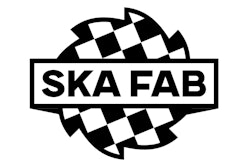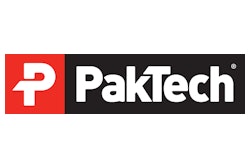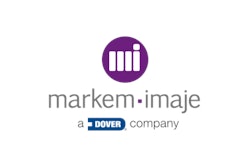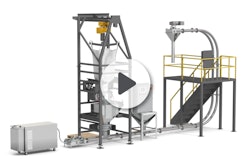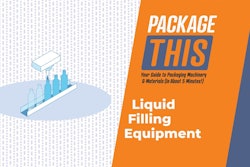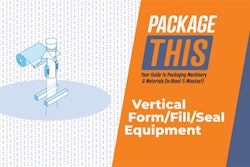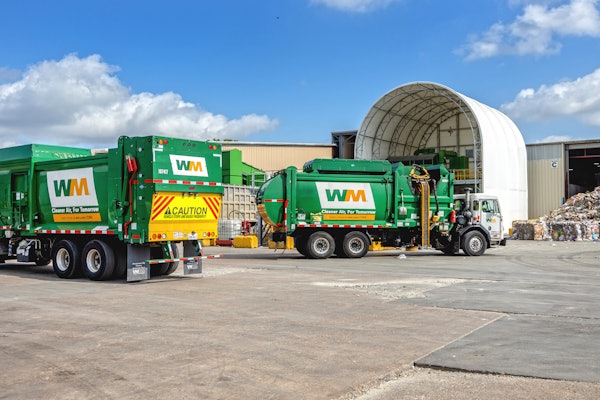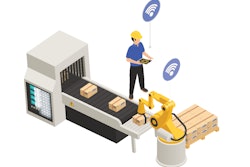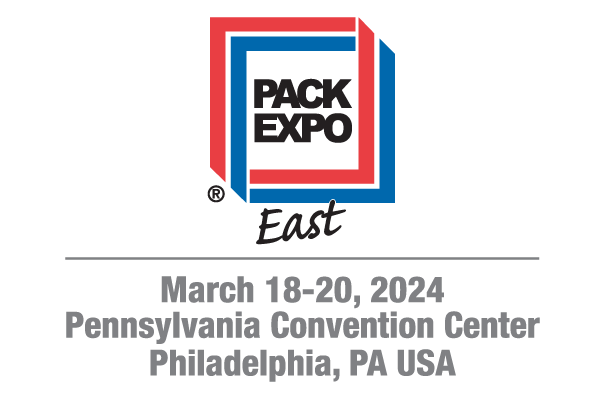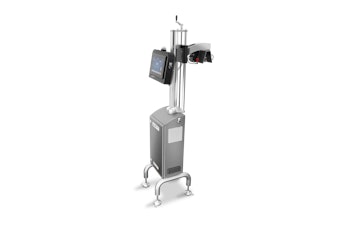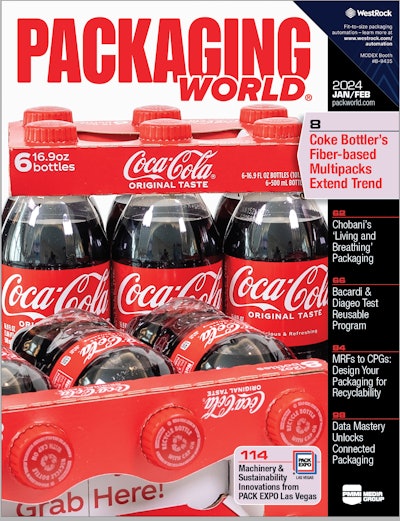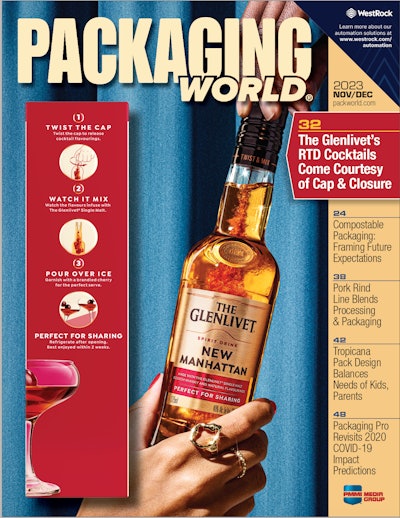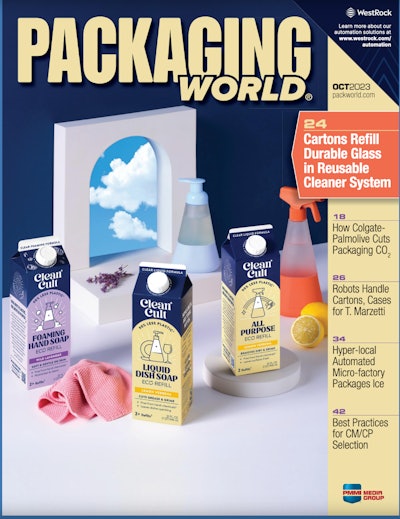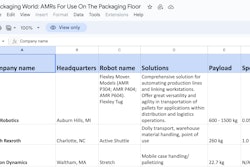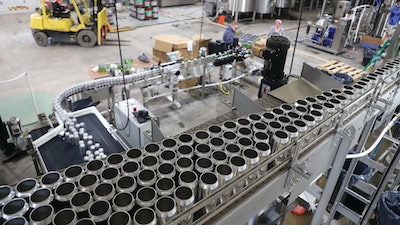
Founded in Meadville, Pa. in 2005, Voodoo Brewing Co. represents an impressive comeback story. Despite award-wining craft beer offerings, the brewery narrowly survived the Great Recession of 2008-2009. But it emerged in 2010 under new ownership with a new lease on life. After brothers Matteo (CEO) and Curtis (brewmaster) Rachocki took the reins, Voodoo quickly assumed a growth trajectory. The first local taproom opened in 2012. A second opened in Pittsburgh in 2015, followed by another in Erie, Pa. in 2016, and yet another was soon to land in State College, Pa. During this flurry of growth, the company recognized the need to produce in larger volume.
So, in early 2017, Voodoo Brewing Co. opened its production facility with practically unlimited room for expansion. The sweeping 10-acre space currently pumps out about 6,000 barrels a year. Given the newfound production capability and rapid expansion, an entirely new business model swam into view.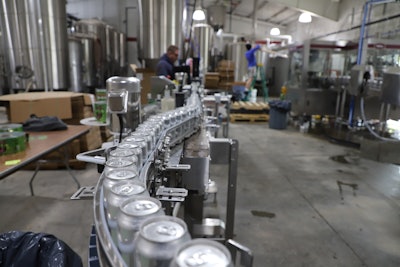
Franchising precipitates pack format changes
“During that time, we put together a model on how to build streamlined, efficient, cost-effective [brew pub-style] restaurants,” Matteo Rachocki says. “We documented it, put together our first operations and Franchise Disclosure Documentation (FDD), and decided to roll out a franchise program.”
This new direction led Voodoo to recalibrate its packaging mix. Like most breweries, Voodoo packages product in a mix of kegs, cans, and bottles. Kegs, of course, are aimed drafts at taprooms or restaurants. On the bottling front, formats include classic 12-oz bottles for volume brews, a 500-mL format for limited release beers, and a barrel aging program uses both 12- and 22-oz bottles. But if you’re following craft brew at all, you know that cans are king these days. Plus, they are quite adept at retail distribution, and are often the best bet for the volumes required of a franchise network.
“When the franchise model started to take off, it really ramped up the need for packaged product,” he says. “That’s because we don’t just service our retail locations. We’re also servicing the greater distribution territory surrounding those wholesalers. That was a major catapult for us to expand our capability on the canning line.”
Previously, the brewery had been using a mobile canning line that it transported back and forth between the original brewery and the new production facility. Speeds were low on the self-engineered canning line, maybe only two cases or 50 cans/min. To help “catapult” canning into high gear, Rachocki first zeroed in on a couple pieces of equipment that he knew he wanted. The first was a ProBrew ProFill filler/seamer combo that runs up to 200 cans/min.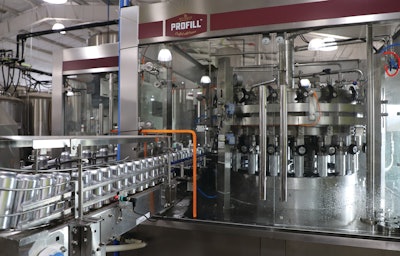 The ProBrew ProFill filler (shown) and seamer are capable of 200 cans/min speeds. At Voodoo, cruising speed is currently closer to 120 cans/min, but the brewery is gradually ramping up throughput.
The ProBrew ProFill filler (shown) and seamer are capable of 200 cans/min speeds. At Voodoo, cruising speed is currently closer to 120 cans/min, but the brewery is gradually ramping up throughput.
“We looked at a bunch of different options. Almost everybody we talked to had a reason why they didn’t like what they had. But the few people we know that have worked with the ProBrew fillers love their machines,” Rachocki says. “Our industry friends told us that this is the only machine consistently canning at under 30 parts per billion on DO [dissolve oxygen]. It’s all solid stainless; there’s nothing plastic on the thing. It wasn’t the cheapest machine, but when you add in the [favorables around] parts, accessibility, repairs, and downtime, it just made a lot of sense.”
Rachocki was also keen on the classic Pack Leader USA 501 labeler. With those two anchor pieces selected, the brothers then turned to Ska Fabricating for the front of the line.
“Every single friend of ours in the brewing community that has a Ska depall[etizer] says they love it. We might have shopped for another option just for a price comparison, but our minds were already made up. We didn’t even really shop elsewhere,” Rachocki says. Filled and seamed cans get a fill-level check via Filtec equipment prior to date coding, accumulation, and labeling.
Filled and seamed cans get a fill-level check via Filtec equipment prior to date coding, accumulation, and labeling.
“We called them to buy a depalletizer but came to find out they offer other solutions and could help with the engineering or do some of the conveyance. I think we ended up redesigning the conveyance on that about four times before we had a solution that I was comfortable with. Our facility’s footprint is substantial, but I want to use all of it. I wanted to be able to expand later and not break the bank now. Drew and KG at Ska got that. … Their design team was great to work with and didn’t try to sell us something we didn’t need. They really got a sense of what we were looking for, and then they worked backward from there.”
The finished packaging line
Finished in August 2022, the canning line at Voodoo begins with a Ska high-trim Can-i-Bus depalletizer. The Can-i-Bus is the original of a range of Ska depalletizing equipment, which includes the even higher production Magic Bus. But this high-trim, mezzanine-level Can-i-Bus model depalletizer was the center of the bullseye for Voodoo’s Rachocki, easily meeting desired production speeds with plenty of runway left for speeding up the line in the future. Ska and MCE conveyance equipment then single file depalletized cans overhead, and they descend toward the filler via an A&E Conveyor Systems Inc. twist rinser. Cans are inverted, rinsed by an ionized air rinser, then twisted upright into a transfer plate to be presented to the filler.
At the heart of the line, cans are counter-pressure gravity filled on the continuous-motion, 24-valve, rotary ProBrew ProFill filler, then seamed on a continuous motion ProBrew seamer, all within a single monoblock enclosure. The canning line makes a 90-deg turn to the left exiting the filler and entering the seamer, then turns another 90 deg in the same direction exiting the seamer. That equates to a full 180-deg line horseshoe, and cans continue downstream in parallel to the upstream empty cans as they approach the filler.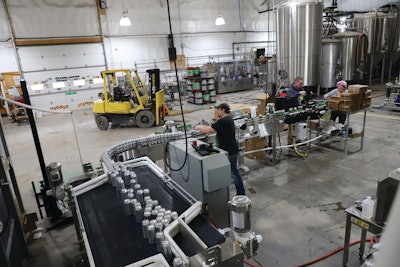 A large accumulation table ahead of labeling, can handle application, and pack-off lets the filler keep filling, even as downstream fixes or changeovers happen.
A large accumulation table ahead of labeling, can handle application, and pack-off lets the filler keep filling, even as downstream fixes or changeovers happen.
Filled cans then get two sets of rinses, followed by an efficient Republic Manufacturing air knife dryer, prior to passing through a Filtec low fill-level reject system.
Coding and marking comes next, and ink is applied via a Markem Imaje CIJ 9450 date coder, the core component of Ska’s D.I.C.S. (Date Inline Coding System). Coded cans on the line make another 90-deg turn to the right this time to enter a large accumulation table by MCE.
“We added an oversized accumulation table because, especially if you’re not using printed cans, you’ve got to do label changes. Also, if we’re running two tandem pack-off lines eventually, it’ll be nice if you can have transfers between the two pack-off lines,” Rachocki says. “We did go overboard on the accumulation side, but I’m glad we did because once the machine is on, it needs to stay on. You don’t want to stop that machine for anying. Accumulation is great because it buys you a lot of time. If you have a hiccup somewhere on the line, you have a chance to fix it.”
The line then makes a final 90-deg turn to the right to be once again parallel with the filler infeed and seamer outfeed, representing a second horseshoe on the line. There, cans receive a p-s label on the Pack Leader 501, which Rachocki affectionately calls “a beast.” Finally, PakTech can handles are applied on an American Canning can-handle applicator, and the contiguous line ends in a manual pack-off station, where 4- and 6-packs of 12- and 16-oz labeled brighstock cans are loaded into pop-up corrugated trays and moved offline for palletization.
Rachocki has considered cartoning and tray-erecting equipment, but the operation hasn’t quite maxed out the 200 can/minute potential that could benefit from cartoning automation. Voodoo tends to run closer to 120 cans/min at this point, and with operators already on-hand to attend to the line, manual pack-off into trays is sufficient. Palletization is mostly manual, with pallet wrapping equipment finishing the line. 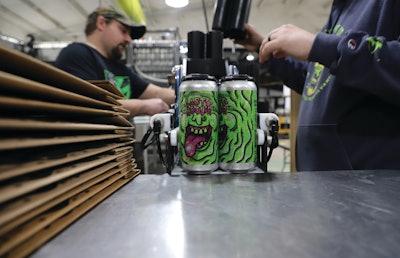 After PakTech can handles are applied to labeled cans, operators pack cans into pop-up trays in a pack-off station that ends the contiguous line.
After PakTech can handles are applied to labeled cans, operators pack cans into pop-up trays in a pack-off station that ends the contiguous line.
“Once we tune this thing up and we’re running at full speed, we’ll add have a second, mirrored pack-off line that will resemble the one we have now. We’ll also add a small diverter to make sure you’re diverting the cans to the appropriate station of the two,” Rachocki says. “That’s just how Voodoo has always done stuff. We bought a brew house too big for our britches, we figured we might as well buy a canning line that’s too big for our britches, make sure it will run well at 100 cans a minute, so we know it’ll also run well at 200 when we need it.”
Other than the eventual mirrored pack-off station, next up for the new packaging line will be a new can size, 19.2 oz cans for two of the brewery’s offerings. Voodoo has a new twist rinser on order that will be able to be swapped in and out to accommodate the larger can format.
For their part, Ska says they had a blast working with Voodoo. When asked if anything made this project unique, Hudson Grigg, senior project manager at Ska, had this to say: “What stood out was working with Matteo, he was just friendly and positive. And, you know, as stuff comes up in these projects, he was just easy to work with. He’s just that kind of guy that you’d really want to go visit his brewery and drink beer with him.”
That’s high praise for the leadership of any growing craft brewery. It’s a character trait that permeates the operation, and will keep Voodoo on a continued growth path. PW






